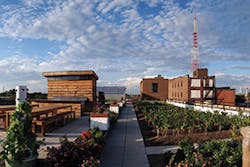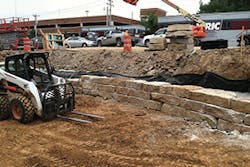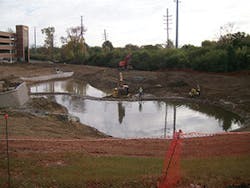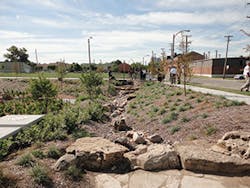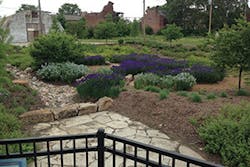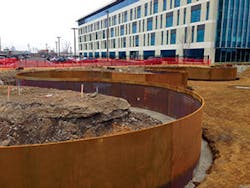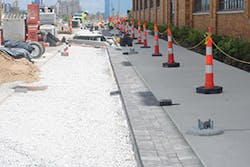St. Louis has been singing the blues for some time—not only musically, but also over stormwater. The city has had combined sewer overflows (CSOs) into the Mississippi River and backed up basement drains in the neighborhoods closest to the river along the city’s eastern edge, causing flooding and pollution.
Years of CSOs resulted in a consent decree with EPA and the Missouri Coalition for the Environment, signed in 2011.
“We got twenty-three years [to correct things], a fair agreement. We thought we might have $6 billion in upgrades. We were able to negotiate that down to $4.7 billion,” says Lance LeComb, manager of public information and spokesperson for the Metropolitan St. Louis Sewer District (MSD).
As the fourth-largest sewer district in the US, MSD serves all of the city of St. Louis and 90% of the surrounding St. Louis County. That territory includes 90 separate municipalities and covers 525 square miles.
The CSOs stem from aging infrastructure and an extensive combined sewer system (CSS). The entire city of St. Louis and parts or all of 22 communities in St. Louis County are on a CSS, totaling 75 square miles.
Part of the consent decree involves adding significant gray infrastructure. LeComb says that of the eight large tunnels planned to temporarily store wastewater, one is finished and three are underway or will be started by the end of 2017. Estimated cost for these tunnels is $1.9 billion.
Another part of the consent decree is the downspout disconnect program for property owners in St. Louis County. So far, MSD staffers have examined some 180,000 homes to assess their downspouts. Having downspouts connected to the CSS is now a code violation. However, because it was not so in earlier years, MSD is paying the costs to correct the situation at each home.
Project Clear is MSD’s initiative to clean up stormwater and reduce flooding through the use of green infrastructure. Funding for Project Clear is included in the consent decree: $100 million to be spent from 2011 to 2034. The first funding—$3.8 million—was allotted to pilot programs installed from 2011 to 2015.
MSD’s goals include reducing CSOs into the Mississippi by 90 million gallons annually and managing runoff from 405 acres (202 of which are impervious). To achieve those goals, MSD is getting in tune with green infrastructure through three separate programs within Project Clear. The small-scale and large-scale Rainscapes programs both focus on bioretention areas, also known as rain gardens, and often include permeable pavers or other forms of green infrastructure. The third program involves demolition of vacant properties, which results in open green space. Projects for all three programs were included in the $3.8 million pilot program.
Project Clear partnered with the Land Reutilization Authority (LRA) to use demolition of buildings and impervious surfaces to lessen drainage from as much of the watershed as possible. As part of the pilot program, 221 structures were demolished—representing a drainage area of 23.6 acres.
The cost for this pilot project was $1.5 million. It reduced an annual of 2 million gallons of CSOs. Six bioretention areas accept drainage from 9.5 acres, removing another 2 million gallons of CSOs. The cost was $1.25 million.
Other pilot projects included two rain gardens serving a drainage area that totaled one-tenth of an acre, and 13 stormwater planter boxes handling drainage from two-fifths of an acre. These removed 0.02 and 0.05 million gallons of CSOs, respectively.
A fifth pilot BMP was the use of soil amendments. Its results were inconclusive. The total drainage area covered by these pilot BMPs was slightly more than 33 acres.
The Early Action program involved grants for green infrastructure projects by both government and private entities. MSD installed six bioretention areas to handle drainage from 9.2 acres.
Six large, neighborhood-scale rain gardens within the Bissell Point watershed were also included in the pilot program, which was designed to learn how these rainscaping components impact CSOs. This program ended in 2015.
“These large-scale rainscapes are one to two acres, typically. We appropriate up to $180,000 per drainage acre. They could be at multifamily residential [properties], pocket parks—the range is pretty broad,” says Bruce Litzsinger, assistant director with MSD’s Engineering Department.
The first of the pilot large-scale rainscapes—which began in 2012 and finished in the early fall of 2013—is the Old North Rain Garden at the corner of Clinton and 14th Street. Partners on the project included the City of St. Louis and the LRA, which donated the land. SWT Design created the landscape design. M3 Engineering Group did the environmental site assessment, and Landesign served as the construction contractor.
Webster University rain garden under construction
This large rain garden cost $185,000. It covers 1.72 acres and is surrounded by public sidewalk, with an overlook at the corner.
“The rain garden captures stormwater from both streets and a nearby alley, instead of it going into the combined sewer system,” says designer Felipe Denarvaez with SWT Design.
He adds, “We daylighted two inlets in two systems with hard-bottomed forebays. The MSD pilot program asked us to explore different ways to access and maintain sediment [accumulation].”
The forebays are made of mortared-in flagstone, and the contractor had joint and size requirements to meet. Maintenance workers can shovel out the forebays or use a small Bobcat to do the work.
The stormwater moves from the forebays into a set of check dams made of natural limestone locally harvested from Missouri. A system of perforated drain tiles forms the underdrain. Aqua-Bric pavers from Belgard were installed here.
A precast concrete overflow structure has a keyhole opening at one elevation to handle excess flow. The runoff then goes back into the CSS. By then, bioremediation has filtered some pollutants.
Denarvaez says that even in an unusually large storm, the four-sided open structure “is able to capture some sediment and pollutants; so it’s still a benefit.”
He describes the Old North rainscape project as “a beautiful facility in a setting that is in high contrast to the [surrounding] environment. It stands out like little jewels.”
Bald cypress trees were planted along the streets. Eastern redbud and serviceberry trees are also part of the project, along with Red Sprite winterberry and “Gro-Low” sumac. Perennials include shining bluestar, blue and tollway sedge, purple coneflower, Siberian iris, great blue lobelia, prairie dropseed, little blue stem, and golden Alexander.
Denarvaez says the project’s main challenge was the neighborhood’s older infrastructure. “Catch basins were brick-constructed, one hundred and fifty years old. There were fifty- to sixty-year-old reinforced concrete pipes. We were constantly asking, ‘How much do we save?’ because you can’t tear up all of St. Louis.”
The Old North Rain Garden project was unusual, says Denarvaez, because “We rarely get to work directly with MSD as design engineers. It was a design, bid, and build project.”
He is pleased with the response from the neighborhood. “We’ve gotten lots of comments from residents in this highly urban area,” Denarvaez says. “It’s very gardenesque, and watching them take ownership of it [was rewarding.] I found a lot of joy in seeing how well received it was.”
He continues, “We incorporated educational signage—we would see the neighborhood kids reading the signs and talking to their parents. The educational aspect was exciting, watching the community understand and connect to our project.”
The Cortex Innovation Community is a nonprofit organization formed in 2002. “Cortex” is an acronym for Center of Research, Technology, and Entrepreneurial Expertise. Its members include Washington University in St. Louis, Barnes Jewish Hospital (now BJC HealthCare), University of Missouri St. Louis, St. Louis University, and the Missouri Botanical Garden. The organization’s main objective is increasing commercial benefits of university and regional corporate research for St. Louis.
The entire Cortex campus covers 200 acres in midtown St. Louis. Its urban location created an ideal place for a large-scale rainscape, part of MSD’s pilot program. The project is actually composed of separate large rain gardens along with other types of green infrastructure.
The project is a good example of how MSD is developing stormwater projects with various private and public partners. This partnership included Cortex, MSD, the Bistate Development Corp., MetroLink, and the city of St. Louis Street Department. Its $5 million cost was partially funded by a Project Clear grant, and the project was finished in 2015.
Photos of the completed Old North rain garden
Rainscaping for Cortex is situated in the four-acre Commons area. The Venue section of the Commons—between Duncan Avenue and the light-rail MetroLink—has a rain garden of 4,300 square feet. The larger 10,000-square-foot rain garden is in the Terrace section, between the MetroLink and Clayton Avenue.
“Each of them has a corten steel wall as a backdrop. We graded the rain gardens down to those walls. That let us contain more volume of stormwater,” says Paul Toenjes, senior associate and studio manager with SWT Design.
The existing soil within the Commons area contained a lot of construction debris. Most of the space had once been a parking lot. The amended soil used was a mixture that MSD recommends, consisting of 70–80% sand base with silt and clay.
Boyle Avenue has a total of 5,600 square feet of curbside bioretention cells. On average, each one is 5 feet wide by 30 feet long. Duncan Avenue has a total of 900 square feet of bioretention cells. Each one is about 7 feet wide by 2 feet long. They frame the parking stalls, which have permeable pavers (Aqua Bric by Belgard) totaling 2,400 square feet.
Silva Cell units from Deep-Root line Duncan Avenue, just east of Boyle. The stackable underground units provide stormwater management and support large tree growth. There are 300 stacked three high on the north side of the street; another 135, also stacked three high, are on the south side of the street.
Some gray infrastructure for managing stormwater is also at work on Duncan. A 72-inch trunk sewer line was laid for approximately 1,800 linear feet down the 10-year-old street. It was then extended an additional 1,000 feet into the campus of BJC.
Trees planted at Cortex include Dura Heat river birch, Skyline honey locust, Red Rage black gum, Shawnee Brave bald cypress, and October Glory red maple. The bioretention areas have Virginia sweetspire, palm sedge, copper iris, common rush, and willow bluestar.
Toenjes was surprised at “how challenging and complicated all of the utility coordination is to accomplish, with easements to negotiate and acquire, and old infrastructure. We had to be 30 feet down to pull it off. In some sections, the elliptical pipe just barely squeezed through.”
Toenjes says that the project’s goal was to handle 1.4 inches of rain falling in two hours, or 90% of the storms. “We actually exceeded that,” he notes.
“We’ve had just really great response from the public,” he says. “We’re creating an open space
in a newly budding innovation district, in the heart of that district. People have really taken to it. They’ve hired an event planner [for public events there].”
“People are using the space and paying attention to the educational signage. We were taking a master plan, with space reserved for stormwater management in a utilitarian way, but now it’s a park and public space, too,” says Bonnie Roy, SWT Design partner. The project, which is about 4 miles from the Mississippi River, continues to draw “a lot of public support. It’s a real success.”
Another innovative, large-scale rainscape project funded by MSD was a partnership between the agency and the nonprofit Urban Harvest STL. This organization provides food to those in need. The agency wanted to expand its operations to grow more food and help more people. Unused space on the building’s 9,100-square-foot roof became the FOOD Roof Farm, the first rooftop farm in St. Louis. The project was completed in 2015.
“The building had good bones. Not great, but strong enough [to support a green roof]. We decided that Hanging Gardens would figure out how to make it hold as much water as possible. We would find a way to make the numbers work,” says Anthony Mayer, CEO of Hanging Gardens in Milwaukee, WI.
The tomato and other food plants growing on the FOOD Roof Farm do absorb some rainwater, but most of the stormwater is not captured through the typical green roof trays of sedums, but through a special growing medium and an under-roof system.
The major absorption occurs via “a special engineered growing medium, a soil sponge that is three inches thick,” explains Mayer. “A section two feet by one foot holds two inches of water per every three inches of thickness.”
This special soil sits in a series of cups, which Mayer compares to ostrich egg crates. The cups allow drainage to the retention system below. Between the rows of plants and the stormwater system are pavers raised on pedestals. There is a gap below the pavers of six to 12 inches. “The entire roof is a big drainage retention board, a German system made by Optigreen,” says Mayer.
The green roof system at the FOOD Roof Farm can absorb up to 17,000 gallons of stormwater per rain event. A backup overflow sends unabsorbed runoff into the CSS.
Mayer says Hanging Gardens has two more similar green roof stormwater projects underway in downtown St. Louis that will qualify for large-scale rainscape grants from MSD: one at a historic office building, and the other at a hotel. He sees this type of green roof as “a cost-effective way to manage stormwater in a dense urban area.”
Construction of the Terrace rain gardens at Cortex
Another benefit of MSD’s rainscaping program is the increased interest in rain gardens throughout the area, even when they are not funded by MSD. One such private rain garden project even inspired a donation of $1 million.
This rainscaping project is at Webster University in suburban Webster Groves, MO.
Bonnie Roy of SWT was the designer. The rainscaping is part of the university’s East Academic Building (EAB) and its newer addition, the Interdisciplinary Science Building (ISB, now called Browning Hall), which earned LEED Gold certification.
Roy began design work on the project in 2008, and construction was finished in 2010. The rain garden is in front of Webster’s East Academic Building.
“We saw this rain garden as a welcome mat or front door of the project,” explains Roy.
“It gets attention, it tells a story about the University’s educational goals and values, and it really has become a showpiece.”
She adds, “The design, for a depressed area holding water at the front of the building, scared the architects at first [because of potential flooding and building damage], but then they got on board with it.”
The rain garden’s “wild and wooly look, with natural bedrock and limestone boulders” accentuated the “neat, traditional architecture” of the building. “And as a vertical surface to get more water in a confined space,” it was very functional, she notes.
The main rain garden near the building’s entrance is 5,572-square-feet. A smaller rain garden on the other side of the building is 2,500-square-feet. Plants in these rain gardens include purple coneflower, bluestar, gray and yellow fruit sedge, southern blue flag, sweet coneflower, and blue cardinal flower.
Aqua Bric permeable pavers from Belgard feed runoff into the rain gardens. Permeable pavers in the parking area cover 5,240-square-feet.
Another rainscaping feature is the green roof on top of the EAB that measures 6,613-square-feet. It was planted with three types of sedum and blue fescue.
The two rain gardens at the ISB (2,831-square-feet and 823-square-feet) function similarly to those at the EAB, but have a more contemporary design to go with the different architectural style.
Changes to the EAB during construction meant that “with the flow of stormwater on the site, there was a portion that we could no longer divert into the rain garden,” says Roy. A new Vortex structure was added to handle this runoff.
The ISB has a vegetated roof of 3,342 square feet, and permeable pavers by Hanover in the plaza area cover 3,043 square feet.
The EAB rain gardens were inadvertently put to the test when ISB construction workers mistakenly “put all the debris into the rain gardens. All of the overflow pipes were filled with sediment within hours, but it was a great lesson learned to see how resilient the plant material was,” says Roy. Using rock or mineral mulch instead of a wood mulch paid off, she notes. It was much easier to sweep out the silt and clean the rocks and put them back.
To meet MSD’s stormwater requirements, the project includes a large (44,134-square-foot) stormwater retention facility that was designed as a lake. The attractive setting has made the site a gathering area for students. Named Lake Amenity, it includes two forebays for silt removal. All runoff from the two buildings—plus some from elsewhere on campus and from adjacent streets—flows to the lake.
Aquatic plants installed include palm, tussock, fox sedge, buttonbush, Allegheny monkeyflower, copper iris, queen of the prairie, blunt spike, and common rush. Science classes use the lake as an outdoor lab.
Installation of permeable pavers on Duncan Avenue
Roy says one of the main challenges in designing the project was keeping maintenance in mind. “Maintenance is at the forefront of our discussions. We have to understand their capabilities for maintenance [later] and still meet their budget.”
Some of Project Clear’s smaller rain gardens are being installed at residences, churches, community centers, and similar locations. Grants of up to $3,000 are awarded annually to selected applicants. Missouri Botanical Garden staff members select the grant winners who must attend workshops to learn about maintaining rain gardens.
“We contracted with them to help market the program,” explains LeComb. “The city itself has dozens of individual neighborhood associations. Now they’re doing annual tours that include their rain gardens.”
Litzsinger notes the increasing popularity of the small-scale rainscape program. “In the model [first] round, there were only eight applications. The second [following year] round had sixty-six applications.”
He adds that the smaller projects are “important for community support for the technology and for maintenance of the technology. The more we can get homeowners involved in maintaining and understanding rain gardens, the better [their support] for the large-scale rainscapes.”
The small rain gardens are “more on the education side and for community support. We capped funding for them at 4% of the whole budget.”
The demolition program within Project Clear also offers the potential for stormwater projects with multiple benefits for residents. Demolition offers MSD a way “to achieve part of the consent decree [requirements] at low cost and with ease. It also has broad impact for our community.” About $13.5 million is available for this program.
LeComb says through LRA, the City keeps ownership of the lots after MSD pays for demolition of the structures. MSD owns the land only if it builds a rain garden on the vacant property.
“We’re working with the city planning agency to make sure the demolition we do would result in clusters,” says Litzsinger, noting that a large amount of vacant land improves the likelihood of a park being created there. “We’re trying to create that opportunity.”
“We’re excited about those opportunities. In five, seven, ten years,
we’ll see what can be done,” says LeComb. “The value of those pieces of green infrastructure is long-term. We need open green space for the consent decree.”
The new tune of green infrastructure and effective long-term CSO reduction is striking a loud chord with St. Louis residents. They’re paying attention to stormwater projects and providing positive feedback.
“We think that support has been good. Since 2004, we’ve had four bond elections. Each one was approved by well over 60% [of the voters],” says LeComb. “They authorized $2.6 billion dollars in debt to lessen the steepness of rate increases. Since 2003, our rates have more than doubled.”
He acknowledges, “It’s a massive amount of money we’re spending, so it’s paramount that we benefit in multiple ways and that we find projects that work for St. Louis in a number of different ways.”
